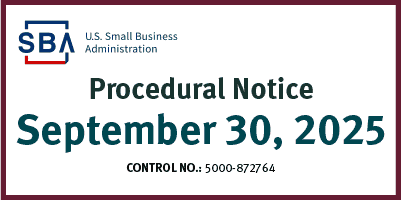SBA’s New Definition for ‘New Business’: What It Means for Buyers and Financing
Amid budget debates and a government shutdown, a quiet change from the U.S. Small Business Administration (SBA) could reshape how entrepreneurs buy and finance small businesses. On September 30, 2025, the SBA issued a procedural notice revising how it classifies certain acquisition deals — and for many buyers, this means one thing: easier access to funding.
What Changed
The SBA’s update to its 7(a) and 504 loan programs eliminates a key barrier known as the “geography test.” Until now, if an existing business wanted to buy another company in the same industry but located in a different market, the SBA often treated that purchase as a “new business.” That classification meant more paperwork, stricter underwriting, and a higher equity injection requirement.
Under the new guidance, geography no longer matters. What matters instead is the continuity of operations, that the buyer and the target share the same business model and industry classification. In practical terms, if a San Antonio cleaning company acquires one in Dallas, it will now be considered an expansion rather than a risky “new business.”
For entrepreneurs eyeing acquisitions, this subtle but powerful shift can open financing doors that were previously closed. It also aligns with a broader federal goal: helping small business buyers keep legacy companies alive as retiring owners exit the market.
Why It Matters
This update comes at a critical moment. Across Texas, thousands of small business owners are reaching retirement age, and many are looking to sell rather than close. Buyers who once struggled to get approved for SBA loans due to location or structure may now find those deals viable.
But that doesn’t mean financing is easy. Lenders still look closely at credit history, available income, and operational experience. The SBA guarantee reduces risk, but banks still want to see preparation. Borrowers should come with a clear transition plan, clean financials, and advisors who understand deal structure.
As we’ve seen with our Entrepreneurship by Acquisition (EbyA) participants, the difference between approval and rejection often comes down to readiness. Buyers who walk into the bank with strong projections, a thought-out management plan, and professional guidance stand out immediately.
Where Caution Still Matters
Even with this change, SBA will still assess credit, collateral, management capability, and debt levels. This isn’t a free pass; you still need strong fundamentals.
The NAICS code match is essential. If your business shifts to a different line of operations, this change may not apply.
Lien perfection, collateral recording, and secondary market rules (especially for 504 loans) are also updated, meaning lenders must adhere to stricter documentation.
What to Do Next
If you’ve been thinking about buying a business in 2026, now is the time to start preparing. Clean up your credit, organize your financials, and start conversations with lenders who know acquisition finance inside and out.
At Emerge and Rise, our Entrepreneurship by Acquisition program helps aspiring owners navigate that process, from evaluating opportunities to connecting with trusted banking partners like Texas Partners Bank, Woodforest National Bank, and Quantefi Pro.
The SBA has quietly lowered one barrier. The next step is yours. Contact us.
Your donations make our work possible.
When you give to Impact, you provide resources that transform the community.





